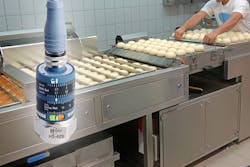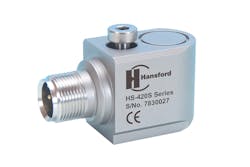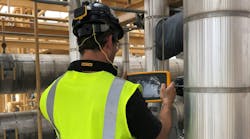While food manufacturing has many similarities with other parts of the process industry, there is one key difference: many of the raw materials it uses are naturally prone to spoilage. This means that serious production problems, such as those created by machine breakdowns, can cause more than a simple delay. In some cases, it can mean ordering a whole new batch of raw materials, which is not an ideal way to drive efficiency.
Many food processing companies — well aware of the need to prevent unscheduled machine downtime — have already introduced predictive and preventive maintenance regimes. These aim to detect and solve machine problems such as failing components before they begin to cause problems. However, some maintenance is still performed when equipment has already begun to degrade. In this situation, a sudden failure can cause unexpected downtime while the run-up to that downtime will have seen a steady decrease in plant efficiency.
Progressive manufacturers know that a proactive maintenance program raises efficiency by reducing the likelihood of an unplanned shutdown. Even if these proactive programs are only applied to individual applications, rather than the entire plant, it can still have a positive effect on profits.
Many food and beverage companies already use condition monitoring techniques such as vibration monitoring, which uses an array of sensors (or accelerometers) to monitor and predict the "health" of rotating machinery to boost efficiency. By spotting the early signs of failure in machine components, it helps to ensure that maintenance is performed at exactly the right time — and well before component failure leads to an expensive machine breakdown.
The HS-100 is available in stainless steel versions that meet strict food industry hygiene standards.
Spotting anomalies with vibration monitoring
Vibration monitoring is probably the most widely used predictive maintenance technique in manufacturing and is similarly popular in food processing. It picks up anomalies in rotating components like bearings, gears and motors by comparing their vibration signature with a "standard" signature. Any small variation, which is easily detectable by modern sensors, indicates a potential problem that can be acted on before it turns serious.
Applying it to rolling bearings, for instance, will pinpoint which components are due to fail and when they will fail. This allows timely replacement of parts and avoids downtime. Although the rolling elements and their movements are very small, vibration monitoring equipment can pick up these movements and supply readings to maintenance engineers, allowing them to make informed decisions on when and how to repair or replace equipment.
Rolling bearings typically produce small degrees of vibration when they are working normally but start emitting higher frequencies when faults develop. It is these higher frequencies that help to identify damage.
Accelerometer understanding
Installing and using vibration sensors to their fullest potential requires an understanding of how they work. Vibration sensors — which measure a quantity of acceleration, so are a type of accelerometer — typically contain a piezoelectric crystal element bonded to a mass. When the accelerometer undergoes an accelerative force, the mass compresses the crystal, causing it to produce an electrical signal proportional to the applied force. The signal is amplified and conditioned using in-built electronics to create an output signal, which can be used by higher level data acquisition or control systems. Output data from accelerometers mounted in key locations can either be read periodically using sophisticated handheld data collectors for immediate analysis or subsequent downloading to a PC, or routed via switch boxes to a centralized or
higher-level system for continuous monitoring.
Accelerometers have become increasingly easy to install and use. Increased demand for them from all sectors of engineering, including food, has driven manufacturers to adapt and enhance their products, and make accelerometers suitable for an expanding range of applications. The best modern accelerometers are robust and reliable, with stainless steel sensor housings to prevent ingress of moisture, dust, oils and other contaminants. They operate over a wide temperature range and measure both high and low frequencies with low hysteresis characteristics and high levels of accuracy.
There are two main categories of vibration sensors: AC accelerometers and 4-20mA accelerometers. Although both operate under the same principle, there are subtle differences between them that engineers need to be aware of. AC accelerometers are typically used with data collectors to monitor higher value assets, such as wind turbines. And 4-20mA sensors are commonly used with programmable logic controllers (PLCs) to monitor lower value assets, such as motors, fans and pumps, making them most applicable to the food industry.
Both can detect imbalance, bearing condition and misalignment, but AC accelerometers can also identify cavitation, looseness, gear defects and belt problems. While 4-20mA devices offer a cost-effective alternative — when AC components are not required — their performance can be enhanced. Hansford Sensors’ HS-500 modules, for instance, can be inserted into the circuit between the accelerometer and the data collector to boost the level of data acquisition.
The HS-420S side-entry accelerometer is sealed to IP68, making it ideal for use in process applications.
Challenging conditions
Modern vibration sensors and associated equipment are built to withstand challenging conditions. For example, a stainless steel 100mV/g AC sensor is an ideal solution for most food and beverage manufacturing equipment. It can be supplied as either a top- or side-entry component and is available with stainless steel enclosures that meet strict food industry hygiene standards.
However, there are times when a more specific sensor specification is required. For example, vibration monitoring of low-speed bearings requires a greater degree of care and experience because the signals they generate are harder to detect. However, some sensor models enable accurate, repeatable readings at low speeds when fitted on the input and output ends of a drive shaft. Such sensors are particularly appropriate for applications such as fans, which may alternate between fast and slow rotational speeds depending on the amount of cooling required.
A vibration sensor offers a simple but powerful form of condition monitoring that has been compared to the check engine warning light in a car. If it detects a problem, it prompts a maintenance technician to perform root cause analysis on the machine to determine what is affecting its performance. Ignoring the warnings in order to continue production can lead to unplanned downtime and major repairs, which will cost far more than a short, planned period of preventive maintenance.
Profit boost
Tools like this help plant operators to increase efficiency by allowing maintenance engineers to move to duties that boost profitability rather than carrying out frequent maintenance on non-critical machines. A good vibration monitoring system helps process industry operators to keep semicritical machine assets up and running, because a single component failure can hold up an entire production line. Vibration monitoring is a powerful tool wherever it is installed, but is most valuable in preventing downtime on lines that include any kind of bottleneck.
This, as much as anything, makes it an ideal investment in the food and beverage industries.
A network of accelerometers on machinery such as fans, motors and gearboxes can help to improve operational efficiency and prevent problems before they occur. After data has been gathered it must be effectively analyzed and interpreted. In some sectors, the best way is to relay outputs to a control room terminal that runs monitoring, analysis and reporting software to provide a real-time display of all key
operating parameters.
To specify vibration monitoring equipment correctly, engineers must ask the right questions from the start, and this is best done in consultation with a supplier that has experience in applying the technique to a range of sectors.
In addition to initial questions such as, "What is the vibration level and frequency range that is to be measured?", engineers need to consider environmental conditions such as temperature, humidity and the presence of corrosive chemicals (which can include those used to clean food machinery).
Promising areas
Predictive maintenance based on vibration monitoring can be applied across the food processing industry. However, in addition to the overall benefit of preventing downtime, there are a few emerging areas where it could prove particularly useful.
Food safety: Consumers are as conscious as ever of food safety but want this to be achieved without the use of excessive additives. High-pressure processing (HPP) is an increasingly popular way of banishing bacteria, but requires robust machinery that runs under more punishing conditions. In such circumstances, components are more prone to wear and tear, which raises the risk of machine failure. Incorporating predictive maintenance, including vibration monitoring, into HPP lines is a way of raising performance while ensuring longer lifetimes with reliable production.
Packaging automation: According to the 2017 Trends in Food Processing Operations report, food industry engineers are increasingly looking to ensure better synchronization between packaging and processing operations so that upstream processing mishaps do not cause downtime on the packaging line. To achieve this, processing companies will need to ensure the reliability of their upstream machinery, an area in which vibration monitoring has a long track record. At the same time, says the Association for Packaging and Processing Technologies (PMMI), machinery manufacturers are incorporating automated maintenance scheduling into their latest models — a sure sign of the growing importance of predictive maintenance regimes within the sector.
Vibration monitoring of food and beverage manufacturing equipment provides early-stage indication of potential problems.
Predictive maintenance and vibration monitoring are established technologies that are well proven in the manufacturing and process industries. Their ability to detect early component failure — at both low and high speeds — along with the availability of affordable, reliable sensors — will increasingly help food processing companies avoid the cost of unplanned downtime.
Martin Armson heads up the U.S. operations for Hansford Sensors based in South Carolina. Armson has a mechanical engineering degree. He first became involved in the vibration monitoring industry in the 1980s. Since then, Armson has worked with several leading companies before joining Hansford Sensors in 2017.






